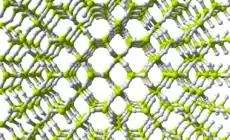Thallane
Thallane (systematically named trihydridothallium) is an inorganic compound with the empirical chemical formula TlH
3. It has not yet been obtained in bulk, hence its bulk properties remain unknown. However, molecular thallane has been isolated in solid gas matrices. Thallane is mainly produced for academic purposes.
 | |
| Names | |
|---|---|
| IUPAC name
Thallane | |
| Systematic IUPAC name | |
| Identifiers | |
3D model (JSmol) |
|
| ChEBI | |
| ChemSpider | |
| 362119 | |
PubChem CID |
|
| |
| |
| Properties | |
| TlH 3 | |
| Molar mass | 207.4071 g mol−1 |
Except where otherwise noted, data are given for materials in their standard state (at 25 °C [77 °F], 100 kPa). | |
| Infobox references | |
It is the simplest thallanes. Thallium is the heaviest member of the Group 13 metals; the stability of group 13 hydrides decreases with increasing periodic number. This is commonly attributed to poor overlap of the metal valence orbitals with that of the 1s orbital of Hydrogen. Despite encouraging early reports, it is unlikely that a thallane species has been isolated. Thallanes have been observed only in matrix isolation studies; the infrared spectrum was obtained in the gas phase by laser ablation of thallium in the presence of hydrogen gas.[2] This study confirmed aspects of ab initio calculations conducted by Schwerdtfeger which indicated the similar stability of thallium and indiganes.[3] There has not been a confirmed isolation of a thallium hydride complex to date.
History
In 2004, American chemist Lester Andrews synthesised thallane for the first time. This reaction sequence consisted of atomisation of thallium, followed by cryogenic co-deposition with hydrogen, and concluded with shortwave ultraviolet irradiation.
References
- "thallane (CHEBI:30437)". Chemical Entities of Biological Interest. UK: European Bioinformatics Institute. 27 November 2006. Main. Retrieved 10 October 2011.
- Andrew, L.; Wang, X. (2004). "Infrared Spectra of Thallium Hydrides in Solid Neon, Hydrogen, and Argon". J. Phys. Chem. A. 108 (16): 3396–3402. Bibcode:2004JPCA..108.3396W. doi:10.1021/jp0498973.
- Schwerdtfeger, P.; Hunt, P. (1996). "Are the Compounds InH3 and TlH3 Stable Gas Phase or Solid State Species?". Inorg. Chem. 35 (7): 2085–2088. doi:10.1021/ic950411u.






